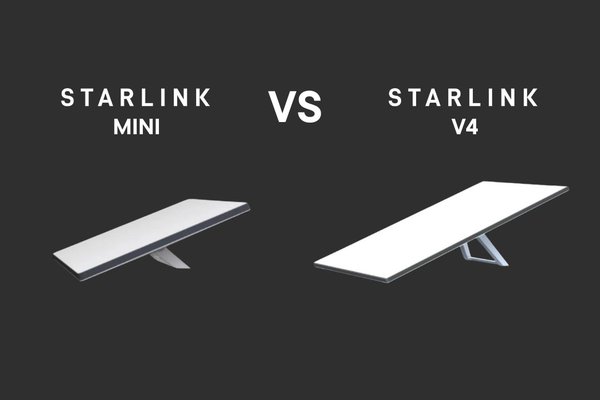Review: Starlink Mini vs Starlink V4
Starlink Mini vs V4: Will it work for you?
Compact, portable, and affordable, SpaceX’s new dish, the Starlink Mini, is billed as a game-changer for companies offering mobile or moving services.

How well does it work and who will it suit? We put it through its paces against the Starlink V4.
The new Starlink Mini is their smallest and most portable dish yet. Designed to provide internet access on the move, it's a smaller and (potentially) more affordable version of the standard Starlink system.
Lowered power consumption means it can be deployed with USB-C or solar power. This makes it ideal for anyone who needs mobile internet in remote areas, such as NGOs and emergency services.
Here’s what Starlink says about the Mini’s key features:
Starlink Mini is a compact, portable kit that can easily fit in a backpack, designed to provide high-speed, low-latency internet on the go. It includes a built-in WiFi router, lower power consumption, DC power input, and max download speeds over 100 Mbps.
But does it live up to the hype? We’ve been looking forward to trying them out in the real world. David Wheelen, our intrepid technical support specialist working in the United States, took one out for a field test in Alexander Springs Wilderness in Florida. Here’s what he found.
What are Starlink Mini’s main strengths?
“The main takeaway from testing is that the Mini isn’t going to be better than the V4 for bandwidth capabilities: the Mini’s main strengths are size, ease of use and setup, and portable power options.
It can be used in scenarios where the amount of bandwidth isn’t necessarily the focus, but a smaller, lightweight package is.
Another takeaway is that both the V4 and Mini still perform well in inclement weather - all testing was done during a storm passing overhead.”
Starlink Mini vs. V4: What are the key differences between the Starlink Mini and the V4?
- It has the same future-proofing as the V4 as it can make use of 2nd Gen satellites.
- It has Wifi 5 and supports up to 128 devices connected at a time.
- It has the same IP67 rating as the V4 along with the same style kickstand for ease of use/setup.
- Speeds are consistent but not as fast as the V4.
- It works great with Peplink routers (we tested it with a Balance 20X).
- The price point via resellers is an unknown variable for the time being.
Starlink Mini vs Starlink V4 Speedtest Comparison
Why choose a Starlink Mini? Who will suit most?
“The Mini is exciting because it makes for some very interesting, versatile & compact deployments. I think this will make changes possible across several industries (transport and logistics, agriculture, education, shipping, automation, to name a few) in the coming years.
One example, here in the States, is in Texas. West Texas has massive swaths of land with many oil extractions rigs (Jack pumps). There is little to no cellular coverage in these areas - they are simply not populated.
In most cases the data needed from this equipment is small but without solid connectivity it’s hard to get this data back to a monitoring center.
A solar-powered Mini could be propped up and a small wireless network created to make an uplink back to a central monitoring center where automations and alerts can be set. This eliminates the need for truck rolls to sites that are often 2 to 4 hours away.”
Who will a Starlink Mini not suit?
“The Mini is not for clients that need large amounts of bandwidth.
The V4 is still the best option here, outpacing the Mini every time due to having more physical antennas.”
What’s the key takeaway from your testing?
“The Starlink Mini is about portability and convenience. It’s super lightweight, minuscule in size and extremely easy to set up. With the built-in router and single power cable, it’s convenient for fast deployments in the field or for propping up in venues where time is at a premium.”
What can you do with the Starlink Mini?
Venn Telecom welcomes the Starlink Mini as another valuable option in connecting everyone, everywhere.
The Mini has lots of potential at an enterprise level with services that are frequently on the move, such as NGOs, logistics and emergency services. Its small size and easy-power options open up a whole new world of possibilities for IoT.
“It's hard not to get dizzy from how fast the connectivity world is changing,” said Martin Langmaid, our CTO. “When I powered on my first Starlink “dishy” in Jan 2021, I immediately knew everything had changed for maritime and rural connectivity.”
”The Starlink Mini doubles down on this. Its physical size, performance and low power consumption make it suitable for use by anyone, almost anywhere in the world. Now that USB-C and solar power are valid power options, anything can be connected anywhere on the planet.”
“Rural broadband, remote device monitoring, remote CCTV installations and in-vehicle connectivity has changed forever.”
Excellent portability at a reasonable price makes the Mini an excellent option for many businesses. Want to know more? Talk to our experts about what the Mini has to offer you.
Talk to our experts